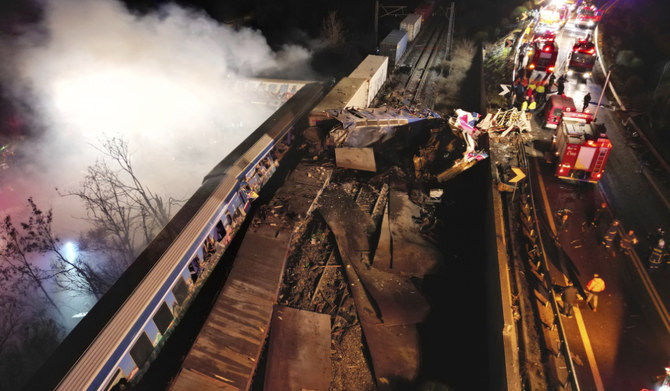In the country's worst ever rail accident, two trains collided in northern Greece, killing at least 43 people and crumpling carriages into twisted steel knots. Rescuers searched for survivors in the mangled, burned-out wreckage on Wednesday.
The impact just before midnight Tuesday threw some passengers into ceilings and out the windows.
Greek Prime Minister Kyriakos Mitsotakis called the collision of the passenger train and a freight train “a horrific rail accident without precedent in our country,” and pledged a full, independent investigation.
He said it appears the crash was “mainly due to a tragic human error.”
At the time of incident, 350 people were riding the train from Athens to Thessaloniki, many of them students returning from boisterous Carnival celebrations. The trains were moving in opposing directions on the same track, despite the fact that the track is double, close to the Vale of Tempe, a river valley about 380 kilometers (235 miles) north of Athens.
During the final stop of the train, in the city of Larissa, authorities detained the stationmaster. The stationmaster is in charge of managing rail traffic on that section of the tracks, albeit neither the man's name nor the reason for the arrest were made public.
In addition, Transportation Minister Kostas Karamanlis resigned, saying he was stepping down “as a basic indication of respect for the memory of the people who died so unfairly.”
Karamanlis said he had made “every effort” to improve a railway system that had been “in a state that doesn’t befit the 21st century.”
But, he added, “When something this tragic happens it’s impossible to continue as if nothing has happened.”
The impact just before midnight Tuesday threw some passengers into ceilings and out the windows.
Greek Prime Minister Kyriakos Mitsotakis called the collision of the passenger train and a freight train “a horrific rail accident without precedent in our country,” and pledged a full, independent investigation.
He said it appears the crash was “mainly due to a tragic human error.”
At the time of incident, 350 people were riding the train from Athens to Thessaloniki, many of them students returning from boisterous Carnival celebrations. The trains were moving in opposing directions on the same track, despite the fact that the track is double, close to the Vale of Tempe, a river valley about 380 kilometers (235 miles) north of Athens.
During the final stop of the train, in the city of Larissa, authorities detained the stationmaster. The stationmaster is in charge of managing rail traffic on that section of the tracks, albeit neither the man's name nor the reason for the arrest were made public.
In addition, Transportation Minister Kostas Karamanlis resigned, saying he was stepping down “as a basic indication of respect for the memory of the people who died so unfairly.”
Karamanlis said he had made “every effort” to improve a railway system that had been “in a state that doesn’t befit the 21st century.”
But, he added, “When something this tragic happens it’s impossible to continue as if nothing has happened.”


















